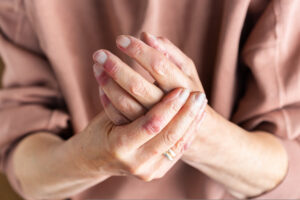Articles
By Angela Ballard, RN
Published On: Feb 20, 2024
Last Updated On: Feb 20, 2024
The word “flare” is often used in discussion of atopic dermatitis (AD) or eczema. But what exactly is an eczema flare and how do people living with eczema describe flares?
The research team at the National Eczema Association (NEA) conducted a study to investigate the definition of flare, which was recently published in the British Journal of Dermatology in January 2024.
“When it comes to atopic dermatitis, flare is a nearly ubiquitous term,” said Wendy Smith Begolka, co-author of the study and chief strategy officer at NEA.
Generally, the term “flare” describes a worsening of symptoms. It’s a word used in conversations between patients and healthcare providers and one used to gauge if eczema is being well managed or if a particular treatment is having an impact.
“But there’s actually no single standardized definition of an eczema flare and no definition that incorporates patients’ lived experiences and perspectives,” Smith Begolka said. “In this study, we wanted to get closer to what ‘flare’ actually signifies to people with AD.”
Research methods
As part of the study, the researchers conducted online focus group discussions with 29 adults with AD. Participants were volunteers from the NEA Ambassadors program, mostly female (69%), Asian or Asian American (35%), 18–35 years old (62%) and diagnosed with AD in childhood (83%). All participants self-reported moderate or severe AD when their AD is at its worst.
In the focus groups, participants talked about how they describe AD flares, how they recognize a flare’s beginning and ending and how they relate to current flare definitions. Transcripts of the conversations were then analyzed.
Key takeaways
While more work on this topic is needed, analysis of focus group discussions revealed six themes on what patients felt were important in a flare definition. They include:
- A change from the person’s perceived baseline or “normal”
- Mental, emotional and social consequences of flares
- Physical changes in the skin
- Increased demand for and focus on management of their AD
- Experiencing the itch-scratch-burn cycle
- Loss of control and loss of some quality of life related to the flare
Patients also associated the experience of having a flare with trying to figure out the cause of the flare, but they did not feel that this was part of the definition.
According to the focus groups, existing definitions of “flares” that have been used in research and clinical trials do not adequately reflect their experiences because these definitions often:
- Incorporate numeric scales which are difficult to apply to multi-dimensional experiences
- Focus solely on the skin, neglecting other aspects of a real-life flare
- Include language that’s “too clinical” to be fully relevant from the patient perspective
Why this research matters
The results of this study highlight the complexity and diversity of AD flare experiences from adult patient perspectives and how current definitions of flares do not resonate with many people with eczema.
“As one study participant told us, ‘a flare is deeper than the skin,’” said Smith Begolka. “Better understanding of this can improve patient-provider communication, relationships and shared decision making.”
The NEA research team is continuing to work on this important topic. The end goal is to eventually have a shared language between patients, healthcare providers and treatment developers about AD flares.






